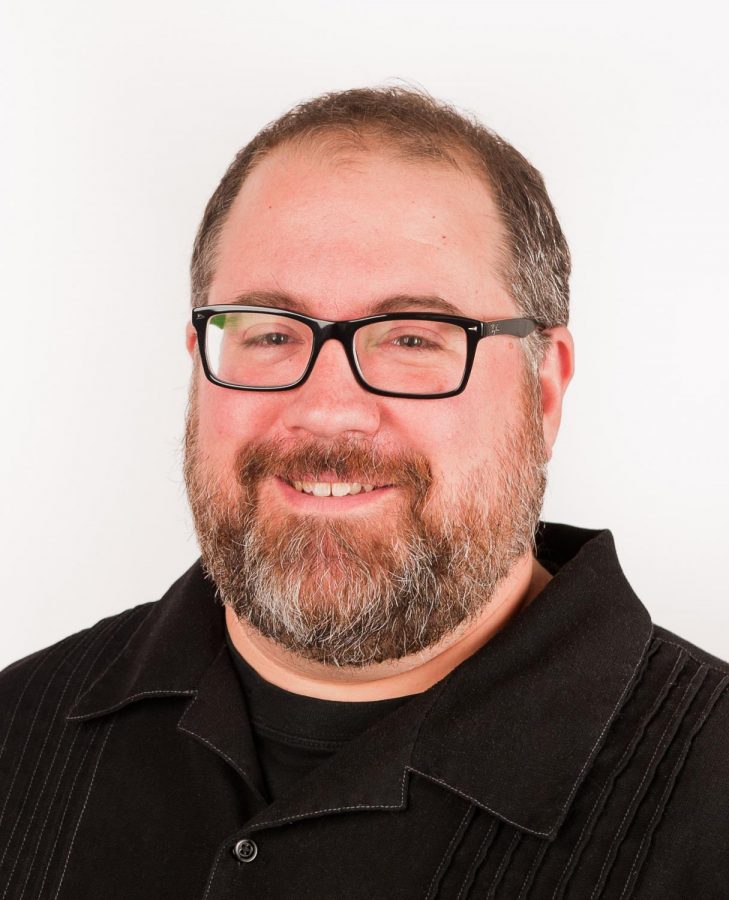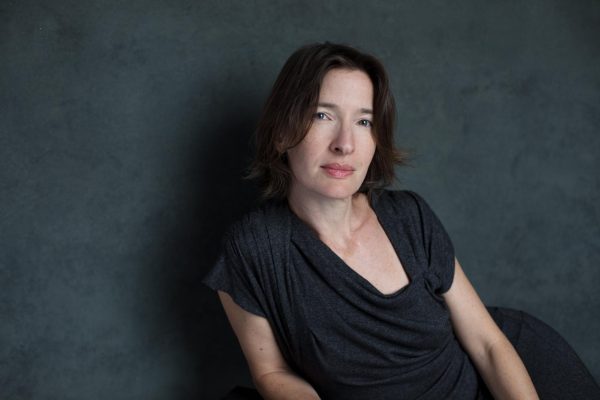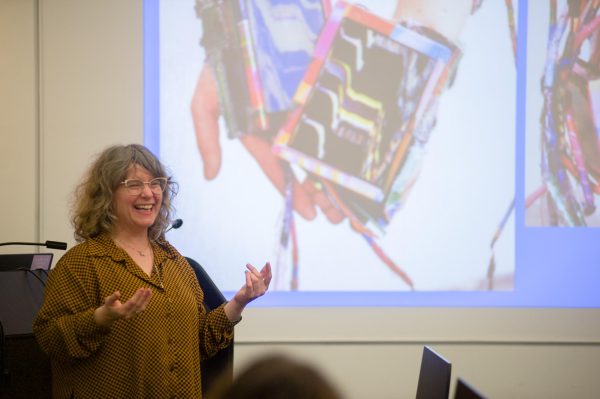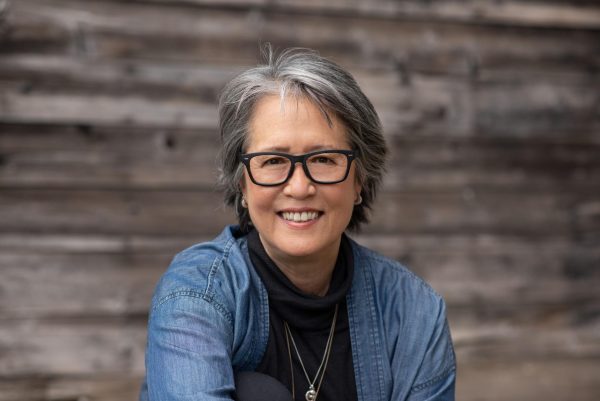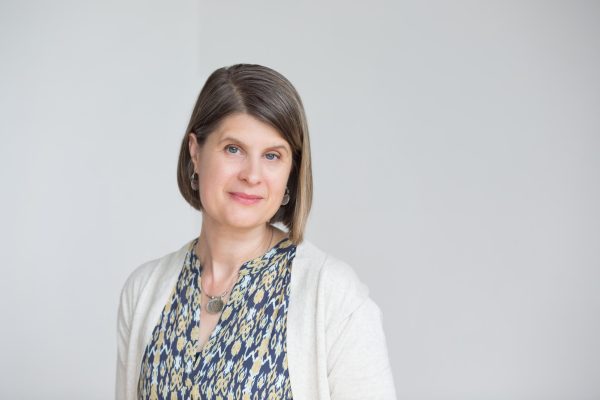Stephan Moore, Sound Artist
Sound Artist Stephan Moore
Stephan Moore is a sound artist currently teaching at the Sound Arts and Industries program at the Northwestern University School of Communication. He creates compositions through improvisation and technological innovation for ambient sonic environments, dance, and theater performances. From 2004–10, Moore toured with the Merce Cunningham Dance Company as a musician and a sound engineer. He is a member of the Wingspace Design Collective and a past president of the American Society for Acoustic Ecology. He has curated several shows, including In the Garden of Sonic Delights at the Caramoor Center for Music and the Arts and The Ears Have Walls at the VGA Gallery in Chicago.
This interview has been edited for length and clarity.
Can you tell me about the evolution of your career in music and sound art?
I think sound artists come from two directions. Either they’re visual artists who want to incorporate sound into their work, or they’re people like me who started out as straight up dots-and-lines-on-a-page composers, and then just ended up wanting to do things that were further and further afield from where that music traditionally goes. And I think there are a lot of interesting and adventurous ideas within the realm of music composition that are happening now. That’s all kind of loosening up and getting broader, but I think sound art liberates you. You can end up having pieces that have sort of an infinite duration, pieces that never have to start or end. I’m interested in creating systems, and creating the rules that those systems have, or collaborating with materials or collaborating with people to create those rules and systems.
I did my undergrad in regular music composition at Western Michigan University in Kalamazoo, [MI]. The conservatory setting for electronic music — which is what I was studying there — just didn’t all fit together. The place was so focused on performers and virtuosity, and there didn’t seem to be a lot of space for people who had just weird ideas about making sound like I was interested in exploring. At that point in time, I hadn’t really discovered the art context for sound. It wasn’t anything my teachers had ever taught me, so I ended up having to kind of stumble on it by myself. While I was in Baltimore after dropping out of Peabody, I was doing a few different jobs, and I picked up a gig teaching sound technology at the Maryland Institute College of Art. [My] interactions with those students were really eye-opening for me. I was like, “Oh, wow. These are my people.” I felt like I found my home, and the folks I wish I’d been in school with.
Now the job I’m teaching is not in a music department, it’s in a film department, and it’s specifically in a program that calls itself Sound Arts and Industries, and it’s a one-year Masters program where students can come and get a deep dive into the world of sound and all of its applications. We have people who want to do podcasting, we have people who want to do film sound design and film scoring, people who want to do sound research work or sound studies, media criticism type work, as well as people who want to be sound artists. That’s the group of folks I’m teaching with and working with right now, and it’s not at all in a music context, and that’s really refreshing.
Can you talk a bit about how collaboration informs your process and what you do?
There’s sort of an old adage — something about how composing is really a lonely phase. You spend a lot of time at your desk. And I’m a much more social creature, so the kind of work that requires me to sit alone in a room for long periods of time is not really what I want to do. I think collaboration is my way of getting out of that. I like making music as an improviser. It’s a real interactive thing where you’re kind of getting to know each other through communicating in sound. I did do a lot of improvisational performance. And also when you’re working on theater pieces, or dance pieces, necessarily there are a bunch of different people who hold the vision of the piece in their head, and those visions are always diverging. So you need a person who’s the director, who chooses, and then everybody has to fall in line with that. But a good director will kind of look at those diversions as they’re happening and consider them and, as opposed to sort of stubbornly sticking to one vision, will kind of farm out the piece to these brains they have assembled, and I like being part of that kind of a team. Sometimes I get to direct. Usually I’m very happy to be the person kind of solving the sound problems and throwing those ideas forward.
Is there anything new happening in the sound art world that’s particularly exciting to you right now? Is there anything you’re planning to try that you haven’t done yet?
There are two ways to answer that. One is just on the level of technologies and ideas — I think that sound artists always seem to leverage whatever’s happening in the culture. So as our handheld devices take on new capabilities, we’ve seen headphone technologies and speaker technologies become cheaper and higher-quality. We’ve seen all kinds of interesting sensors get built into [phones]. I think that people are always taking advantage of these new technologies. There’s kind of an explosion right now in geo-locative sound, which is sound that is responsive to your location through your phone. There’s a company now called Detour, which is doing these very sort of slick, commercially produced sound walks through cities, where you have the headphones on and it’s giving you the history of the neighborhood. These walks have been created for Detour and they’re selling them on a website that’s kind of like a business model. It’s very strange because it takes it, to me, out of the realm of sound art and kind of into the museum guided tour, in a way. But they’re pretty creatively done.
But there are a lot of artists who are taking similar technology and using it to decorate a sound with space, and I’ve been eager to try a large scale geo-locative piece. I have a couple ideas for where that might happen, but I feel like that’s always the province of sound art and the arts in general. As soon as there’s a new thing to try, a lot of people grab it and become early adopters and try to use it. The thing I’ve noticed in the world of sound art overall that’s been really exciting is just that there is so much recognition of it right now in traditional institutions. Just last year there was a huge and really wonderfully curated, wonderfully put together show at the [SF]MOMA, called Soundtracks, I think. It was a number of really great sound art pieces by a number of really great artists. That was kind of the first big show of that kind in the U.S. since the 2013 Soundings show at [the New York] MoMA, which was similarly scaled but maybe not as successful in how it was put together. This last year, I think up until a few weeks ago, there was a huge show at the Rubin Museum in New York called The World is Sound that focused on the intersection of sound art and Buddhism, because it’s a Tibetan and Buddhism-focused museum … really prominent artists, really interesting work. The Museum of Art and Design had a big show that was all sound-focused work. The stuff they show tends to be more on the crafty side of things, so it kind of liberated them to do a very different sort of show with some pieces that were strictly fine art, high art, but then also … a room that was basically a bunch of really creatively designed synthesizers by different synthesizer companies, so that was very much an industry room. They had a room which was a bunch of sound art and fashion intersections. They were taking it in different, broader directions than some of the more strictly-art museums will.
I have a show that I co-curated up right now in Chicago at a place called the Video Game Art Gallery, which is a place that focuses on the intersection of the fine art world and the independent video game maker world. They do shows on a variety of different topics. I curated a show that was all about the creative use of sound as interface in games, and I feel like everywhere you look there’s just a lot of these shows going on right now. Whether it’s a fad — I think that’s sort of a popular way to talk about it, “Oh, sound is all the rage right now, it’s a fad,” whereas there’s a lot of sound work that hasn’t been shown that’s really exciting work that people find really engaging, and it’s having its moment in the art world right now. Whether it’s kind of a fad and it goes away for a while, or whether this just makes it something that’s sort of a natural thing that becomes an ambient part of every show, I think it’s just an interesting set of developments. I haven’t done a real statistical analysis of this, but anecdotally I just have the sense that there’s a lot more sound art being shown now than any other time previous, so that’s an exciting moment to be in.
Do you feel that sound art holds the same power in documentation — like film and recording — as it does in experience?
I think piece by piece it’s different obviously, but if I were going to make a blanket statement about that, I feel like the answer is definitely not. So much about what I think inspires sound artists, and many artists — you can’t talk about them as a herd, you know — but I think what inspires a lot of people is that experiential feeling of being in a particular space and experiencing the sounds coming at you the way they do. [For example, in a piece by Annea Lockwood] the hair stands up on the back of your neck. You’re sitting on a bench or laying on a hammock and these amazing clouds of sound are just rolling at you out of the bushes. You can’t see where anything’s coming from. And some of them are actually quite threatening, and really have some growl to them, and others come in like a mist and just sort of float through. To be there and to feel how it works in the space, they really composed it and mixed it for that space. They actually sat there with a computer and set levels and did mixing with the set-up in the underbrush. It wasn’t like they made it in the studio first and then just plunked it in the woods. I think there’s definitely something you can’t help but lose. On the other hand, if documentation is all we have, if you get documentation or you get nothing, I’d rather have the documentation. But to me documentation almost always pales in comparison. Sometimes you get really quirky, wonderfully made documentation that can stand on its own, in its own right as its own art piece, and then you have that — and it’s seductive to confuse that with the work. It’s always a separate thing, but for me since I’ve experienced the pieces, it jogs my memory of what the pieces were — to see the setting again, to hear the sounds again. I don’t really have the illusion that it preserves the piece. It really just preserves some of the ideas in the piece. And even though it’s not really enough, it’s better than nothing.
What is the purpose of sound art for you?
Gosh. What’s the purpose of a song you write? What’s the purpose of a symphony? What’s the purpose of a sculpture? I feel like these are all ways of getting at or expressing something that we can’t do just in words. For me it’s very much about sharing an experience of awareness — when I’m at my best as a human, I feel like my awareness is really plugged into the world around me. And I feel that with good art, I come away from it seeing differently or hearing differently or thinking differently about the world around me. It shares a perspective. More than anything else, it just activates us. I feel like that’s the kind of experience I want to be able to create. For me, there are places that sound as a medium in general allows people to go, where it’s hard to go [there] with any other medium. As a composer, which is how I first got into this world, I found that I could do some of that in music. But some of the conventions of music or the limitations of traditional music got in the way of getting to some of the experiences I wanted to have. And so that’s why I, without a whole lot of confidence at first but then with more confidence over time, started peeling away at some of those other trappings to get at what I wanted to make and do.
Is there anything else that you want to say?
I think the only thing I would add is how great it is to be here at Oberlin, and how grateful I am to Abby Aresty who brought me here, and to her colleagues. It was so nice to see the entire TIMARA faculty at my talk last night. I’ve been so many places where the faculty barely bother to show up to things, so it was so wonderful to see all of them there and participating and engaged. The facilities here seem fantastic, the program seems fantastic. I hope to get to talk to more of the students today. It’s exciting to be here.


